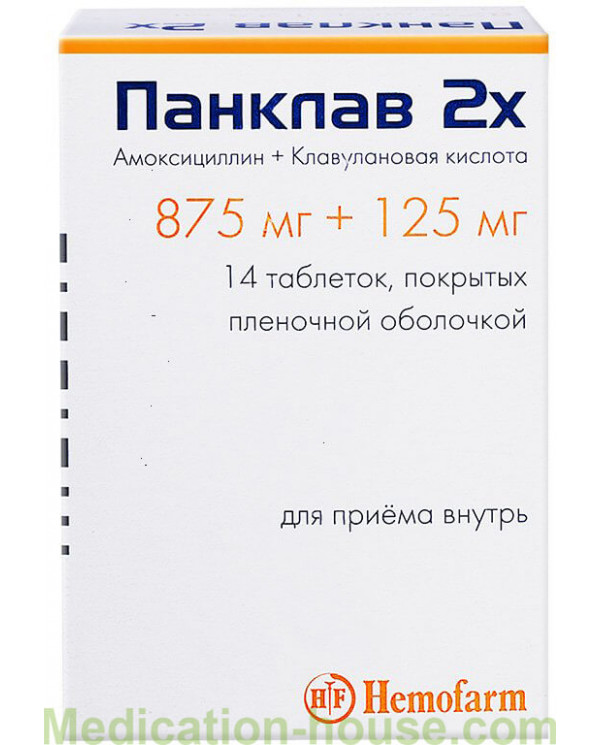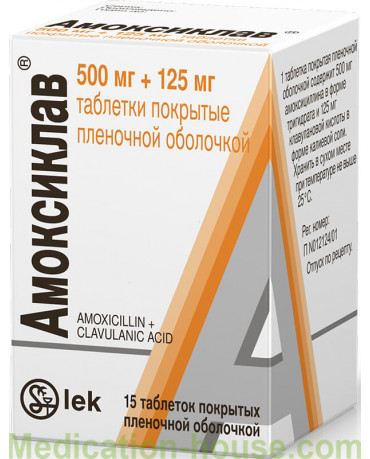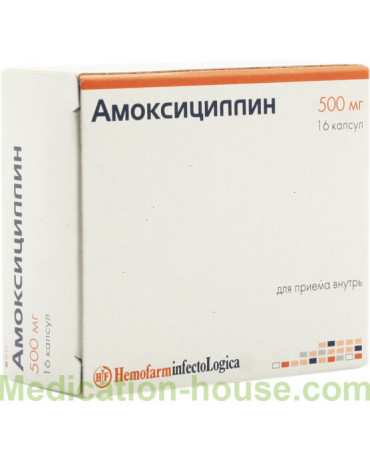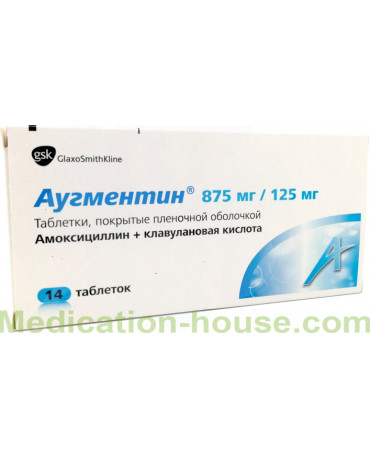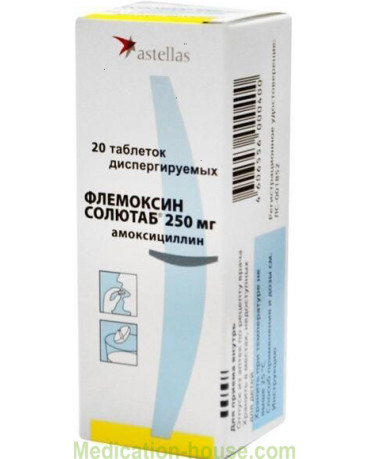Panklav 2x instruction
You can buy Panklav 2x here
Indications
Infectious and inflammatory diseases caused by microorganisms sensitive to amoxicillin / clavulanic acid:
- infections of the upper respiratory tract and upper respiratory tract (including acute and chronic sinusitis, acute and chronic otitis media, peritonsillar abscess, tonsillitis, pharyngitis);
- lower respiratory tract infections (acute bronchitis with bacterial superinfection, exacerbation of chronic bronchitis, pneumonia);
- urinary tract infections;
- infections of the pelvic organs;
- infections of the skin and soft tissues (including after the bites of animals and humans);
- infections of bones and joints (including osteomyelitis);
- infections of biliary tract (cholecystitis, cholangitis);
- infections in dentistry.
Contraindications
- hypersensitivity to the active and / or auxiliary components of the drug Panklav 2X;
- hypersensitivity to beta-lactam antibiotics (penicillins, cephalosporins, carbapenems, etc.);
- A history of cholestatic jaundice and / or abnormal liver function caused by the administration of a penicillin antibiotic or amoxicillin / clavulanic acid combination;
- impaired renal function (creatinine clearance less than 30 ml / min);
- Infectious mononucleosis;
- breastfeeding (lactation);
- children's age up to 12 years and / or body weight less than 40 kg (for tablets 875 mg / 125 mg).
Carefully
Hepatic failure, chronic renal failure (creatinine clearance more than 30 ml / min), history of pseudomembranous colitis, old age (over 65, hyperkalemia, pregnancy.
Use during pregnancy and lactation
When pregnancy can be used when the benefits of its use for the mother far exceeds the risk to the fetus. If necessary, the use of Panklav 2X during lactation breastfeeding suspend.
Special instructions for Panklav 2X
With a long course of treatment, it is necessary to monitor the state of the function of the blood-forming organs, liver and kidneys.
Patients with severe impaired renal function require adequate dose adjustment or an increase in the intervals between doses of Panklav 2X.
In order to reduce the risk of side effects from the gastrointestinal tract, Panklav 2X should be taken at the beginning of the meal.
In order to prevent the development of crystalluria, Panklav 2X should be washed down with a relatively large amount of water (0.5 - 1 cup).
Unchanged amoxicillin is excreted in the urine. High concentrations of amoxicillin give a false-positive reaction to urine glucose when using Benedict's reagent or Felling's solution. It is recommended to use enzymatic reactions with glucose oxidase.
Bacterial or fungal superinfection (Pseudomonas spp., Candida albicans) may develop due to the growth of microflora insensitive to the preparation, which requires a corresponding change in antibacterial therapy.
During drug therapy as a result of exposure to the toxin C. Difficile pseudomembranous colitis may develop. In the case of severe diarrhea, as in the case of diarrhea lasts 2-3 days, you should see a doctor as soon as possible. With the development of mild diarrhea on the background of Panklav 2X, antidiarrheal drugs that inhibit intestinal motility should be avoided; kaolin or attapulgite-containing antidiarrheals may be used.
Since Panklav 2X contains potassium, it is recommended to be careful when prescribing it to patients with initial hyperkalemia.
It is recommended to use caution when prescribing PANKLAV 2X patients with hepatic insufficiency and to ensure regular laboratory monitoring of liver function.
With the appearance of icteric staining of the skin, eye proteins, darkening of the color of urine and / or clarification of feces, it is urgent to consult a doctor.
In patients with hypersensitivity to penicillins, allergic cross-reactions with cephalosporin antibiotics are possible. It is not recommended to use Panklav 2X in infectious mononucleosis and in case of suspicion of it, since Panklav 2X can cause an erythematous skin rash, which aggravates the symptoms of the disease / makes it difficult to diagnose.
In newborns born to mothers who received prophylactic therapy with amoxicillin / clavulanic acid for premature rupture of the membranes (fetal bladder) in preterm pregnancy, there is an increased risk of developing necrotizing enterocolitis.
Influence on ability to drive motor transport and control mechanisms
During the period of treatment it is recommended to use caution when driving vehicles and engaging in other potentially hazardous activities, as dizziness may develop.
Composition of Panklav 2X
1 tab .: amoxicillin (in the form of amoxicillin trihydrate) - 875 mg., Clavulanic acid (in the form of a mixture of potassium clavulanate and microcrystalline cellulose (1: 1)) - 125 mg., Auxiliary substances: microcrystalline cellulose - 510.35 mg, sodium carboxymethyl starch ( Type A) - 32.8 mg, magnesium stearate - 32 mg, silicon dioxide, colloidal anhydrous - 24 mg, butylhydroxyanisol - 0.85 mg.
The composition of the film shell: hypromellose - 34.84 mg, titanium dioxide (E171) - 17.42 mg, propylene glycol - 8.17 mg, talc - 3.57 mg.
Dosage and administration
Inside, drinking water; at the beginning of the meal (to reduce the risk of side effects from the gastrointestinal tract), 2 times a day, strictly observing the interval between meals at 12 o'clock
Adults and children over 12 years old.
Adults and children over 12 years old (weighing 40 kg or more) - take 1 tablet 2 times a day, every 12 hours.
The maximum daily dose of amoxicillin for adults - 6 g, for children - 45 mg / kg / day.
The maximum daily dose of clavulanic acid for adults (in the form of potassium clavulanate) is 600 mg, for children -10 mg / kg / day.
The course of treatment is 5-14 days; set individually, taking into account the characteristics of the pathogen, localization and severity of infection.
Dosing for renal failure
Tablets of 875 mg / 125 mg should be used only in patients with creatinine clearance of more than 30 ml / min, and dose adjustment is not required.
Patients on peritoneal dialysis do not require dose adjustment. Patients on hemodialysis may require dose adjustment.
Important! If Panklav 2X is missed, take the pill as soon as possible, without waiting for the next dose. Then observe equal intervals of time between doses - 12 hours each. Never take a double dose to compensate for the missed dose!
Side effects
Very often - more than 10%; often - more than 1 and less than 10%; infrequently - more than 0.1 and less than 1%; rarely more than 0.01 and less than 0.1%; very rarely - less than 0.01%.
From the side of the central nervous system: infrequently - dizziness, headache; very rarely - agitation, anxiety, reversible hyperactivity, insomnia, behavior change, convulsions.
On the part of the gastrointestinal tract: often - loss of appetite, nausea, vomiting, diarrhea; infrequently, dyspepsia, moderate asymptomatic increases in the activity of alanine aminotransferase, aspartate aminotransferase, alkaline phosphatase, and / or an increase in the concentration of bilirubin; rarely - pseudomembranous colitis, discoloration of teeth (reversible, removed by hygienic means); very rarely - “black hairy tongue”, hepatitis, cholestatic jaundice, liver failure (more often in the elderly, in men, with prolonged therapy), stomatitis, glossitis.
From the side of blood-forming organs: rarely - neutropenia, thrombocytopenia / thrombocytosis, hemolytic anemia; very rarely - leukopenia, agranulocytosis, an increase in prothrombin time and bleeding time, eosinophilia.
From the urinary system: very rarely - interstitial nephritis, crystalluria, hematuria.
Allergic reactions: infrequently - urticaria, rash, pruritus; rarely, erythema multiforme; frequency is not known - angioedema, anaphylaxis, allergic vasculitis, Stevens-Johnson syndrome, toxic epidermal necrolysis (Lyell's syndrome), bullous exfoliative dermatitis, acute generalized exanthematoid pustularis, a syndrome similar to serum sickness.
Other: often - candidiasis of the skin and mucous membranes; very rarely - the development of superinfection.
Drug interactions
Antacids, glucosamine, laxatives, aminoglycosides - slow down and reduce absorption; ascorbic acid increases absorption.
Bactericidal antibiotics (including aminoglycosides, cephalosporins, cycloserine, vancomycin, rifampicin) have a synergistic effect; bacteriostatic drugs (macrolides, chloramphenicol, linkosamides, tetracyclines, sulfonamides) are antagonistic.
Increases the effectiveness of indirect anticoagulants (suppressing the intestinal microflora, reduces the synthesis of vitamin K and the prothrombin index). At the same time taking anticoagulants, it is necessary to monitor the blood clotting indicators.
Reduces the effectiveness of oral contraceptives, drugs, in the process of metabolism of which para-aminobenzoic acid is formed, ethinyl estradiol - the risk of bleeding "breakthrough".
Diuretics, allopurinol, phenylbutazone, nonsteroidal anti-inflammatory drugs, and other drugs that block tubular secretion, increase the concentration of amoxicillin (clavulanic acid is derived mainly by glomerular filtration).
Allopurinol increases the risk of skin rash.
Overdose
Symptoms: nausea, vomiting, abdominal pain, diarrhea, disruption of water and electrolyte balance; possible excitement, insomnia; there are isolated cases of seizures and crystalluria in patients with initially impaired renal function. There are no reports of death or the development of life-threatening adverse events in overdose of Panklav 2X.
Treatment: symptomatic; gastric lavage and absorption of the absorbent is effective if Panklav 2X was taken less than 4 hours ago. Hemodialysis is effective.
Storage conditions
Keep out of reach of children at a temperature not exceeding 30 ° C in the original packaging.
Shelf life - 2 years.
Terms of sell
You don't need a prescription to buy Panklav 2x.

